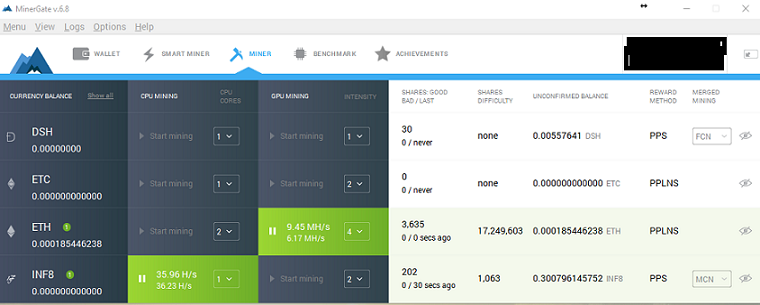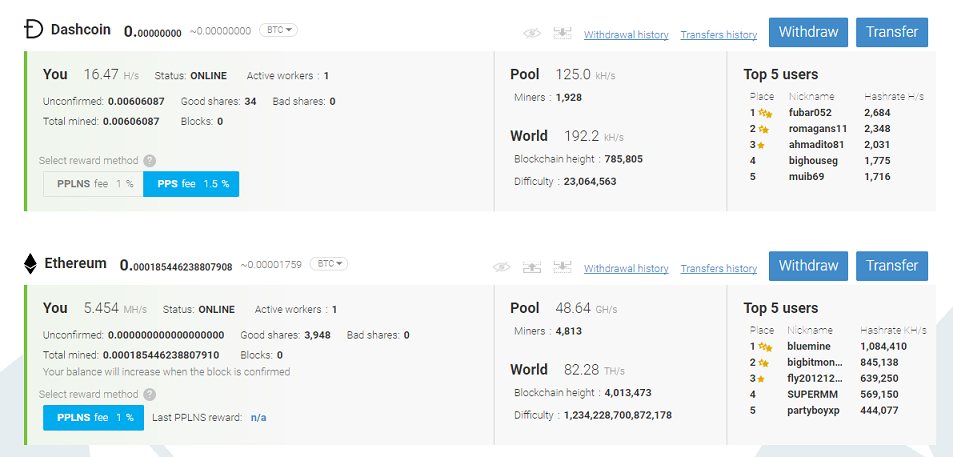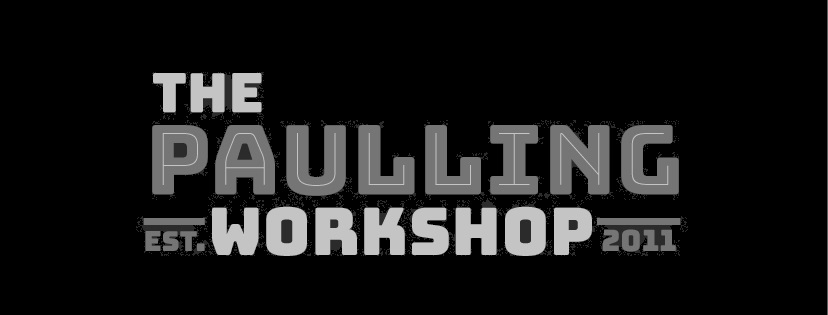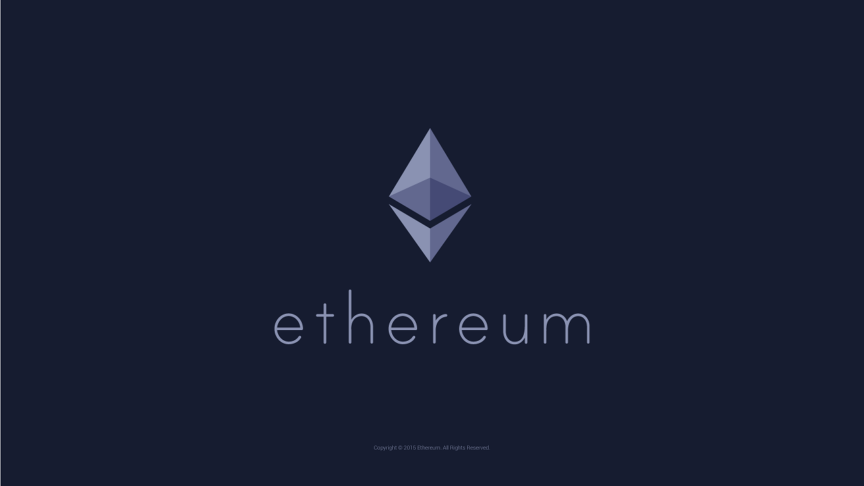We’re going to do something a little different today. This is still a tutorial, but not for something in the real world. This week’s tutorial is all about Ethereum mining!
So what is that then? You’ve probably at least heard of Bitcoin in the news at some point. Bitcoin was the first, large scale digital currency to really take off and has been the source of a lot of controversy and confusion since it came out in 2009. Lets take a look at digital currency’s history real quick to get a feel for what it’s all about.
Essentially, digital currency is a peer-to-peer system of money where transactions take place between users directly, without a central system, like a bank. The transactions are verified in a public ledger called a “blockchain”. Individual bitcoins are stored in a digital “wallet”, which is just a file on your computer, and you are responsible for keeping it safe. Just like in real life, if someone gets access to your wallet, they can spend you money as if they were you, but since no “real” money is being exchanged and nothing is insured, there is no way to get it back. In the early days, news sites referred to it as a kind of “wild west” where anything goes, but in reality it is very safe, and except for a few, high profile “heists” of major online wallet repositories, it has remained relatively stable.
At this point, over 100,000 online merchants, and a few real world places, will accept Bitcoin as a form of payment. Some major companies have gotten on board with Bitcoin payment, like Tigerdirect, Newegg, Dell, Dish Network, Virgin Galactic, and Microsoft. One major incentive for accepting digital, peer-to-peer currency is that instead of the typical 2-3% charge imposed by credit card processors like Visa, merchants accepting digital currency often pay no fee at all.
Despite the natural volatility of a currency that is new and also not backed by real world goods (like gold in a vault), many people have used digital currency as a way to preserve real world savings. Some Argentinians have bought bitcoins to protect their savings from high inflation rates in a failing economy and after a large riot in 2012 in Cyprus, Bitcoin purchases rose drastically due to fears that savings accounts would be confiscated by the government. In 2013, Forbes named Bitcoin the best investment of the year. In 2014, a pricing plummet caused Bloomberg to name it the worst investment of the year, and then in 2015, it was back on top of the Bloomberg currency tables.
So what exactly is Ethereum and ethereum mining, and why are we looking at that now, in 2017, instead of Bitcoin?
Bitcoin was the first, and is still the largest, digital currency, but there are lots more. Ethereum is now the fastest growing online currency, but its still in it early phase of growth, which is why we want to begin the process of ethereum mining.
Mining?! What the heck is that?
So let me backup. There are two ways to get a “cryptocurrency”. The first is the most simple. Buy it with real world cash. There are trading platforms online that will take real money in exchange for digital money, and vice versa when youre ready to cash out. The value of a “bitcoin” or “ether” fluctuates daily, sometimes rapidly, and this can be either really good or really bad, depending on what you’re trying to do. But many folks who got into Bitcoin in the early days are now millionaires, because a bitcoin from 2009’s early price of $0.50, is now worth over $600, assuming they held onto it this long, like many people do.
The second way to get currency is to “mine” for it. Mining is the name for contributing computing processing power to doing accounting sums for the platforms behind the currency, which helps verify the accuracy of the public blockchain. When lots of people are continually computing the same things, it keeps any one person from saying “my account is different. I actually have 10 billion dollars” because everyone else’s public ledger (the complete, total history of every single persons transaction history) is the same.
For participating in the record keeping, you are essentially rewarded with keeping the books. It takes a good deal of computing power to make money, and these systems have led to some enterprising individuals to create extremely elaborate “mining farms”, because the more total power you have, the more you CAN get paid. I say “can” because its not guaranteed that you get paid just for telling your computer to crunch some numbers. Its a bit more complex that that.
For the sake of this article, I’m going to give you a quick runthrough of how it works, in simple terms, because its insanely complicated, but you don’t actually have to fully understand it to get started.
The blockchain is the center of everything. Its an incredibly complex, cryptographic algorithm that is the backbone of the system. You can think of it like an “append-only” ledger, where you can add to it, but cant change it. The amazing part is that there is no central governing body, a bookie, a bank, nothing. Its a decentralized, crowd powered spreadsheet. Crypto-enthusiasts say it “has the power to tip long established powers that have governing authorities, like banking, the internet, and politics”.
Every time you make a transaction, that transaction is put in the ledger, which is then sent to literally everybody. Everybody then checks it against everyone elses for inconsistency. The order or transactions is also verified, so that Timmy (who has $100) cant spent his $100 at one store, and then quickly spend it at another store before the transaction is verified. That order of transactions is determined by a complicated cryptographic process that relies on the combined computational power of the crowd. Normally, something like this would only be accomplished by a few individuals who desire justice, but the brilliant part is that it incorporates a “self interest” in participating. If your computer, or computer pool, solves the puzzle of who is next in line first, you are rewarded with a coin. If you want to mine coins, you HAVE to use your computational power to verify the blockchain when your turn comes up. It’s a perfect, libertarian implementation for fans of digital currency, because its entirely based on your self interest.
The difficult part is actually being the individual who solves the puzzle. Its entirely up to the luck of the draw on whether your contributed power in the system is the one that solves it and is rewarded. You don’t get participation medals. Think of it like a lottery. If there are a thousand, equal value tickets, and you have one ticket, then your probability of winning is 1 in a 1000. If you could get 100 tickets, you’d have a 1 in 10 chance. In digital currency, those tickets are called “hashes” and you are solving hash puzzles. My computer, at full power, can solve about 9.5 Megahashes/second, which is quite a bit for a single GPU computer, but insignificant in the total number of hashes/second being “solved” by the worlds sum of 5.07 exahashes/second. 1exahash is = 10 billion megahashes, so i have a 9 in 50 billion chance of solving the puzzle, which is so tiny its not worth doing. You’re not going to get paid.
But what if you could join a pool of people who are like minded in that they have small systems, and they want to band together in a group and agree to share the winnings? Say my group has 2.4 Petahashes/second (because it does) and we have a collective 0.002% chance of solving the problem. Thats small, but much much larger than 9 in 50 billion, and there are lots and lots of problems per day. In fact, this specific pool solves a hash every few minutes, and those coins are divided up evenly among the group based on your individual contribution to the pool, no matter whether your specific computer was the one to solve the problem or not. Its basically hedging your bet. You dont get everything when you win, but you win more often. This is the kind of system we are going to setup today.
The reason we are going to look at Ethereum is because the worldwide total number of people solving hashes is significantly less than with Bitcoin, which means we have a much much greater chance of solving the problems, which mean we accumulate more coin, which means if the value of the coin continues to rise, we can make more real world money when we cash out. To make money, you need a combination of computer power, time, and good luck picking a digital currency that is going to do well in the future, much like picking stocks. Bitcoin is established, like a fortune 500 company, so the price is high, but its relatively safe now, but newer currencies are easier to get in on the ground floor, more volatile and risky, and more fun. 🙂
How to Mine Ethereum
Step 1: The first thing we need is an Ethereum wallet. Head here to download the latest wallet : Ethereum Wallet Download. click on the latest version, and scroll down to find the latest installer for your system. When you install the wallet, its going to download the full blockchain from “peers” online, and its going to take a while, because right now its 2.4 GB, so let it run while we move on to the next step. Once its finished, just create an account with a super safe password, because anyone with your password can access your money.



Minergate Supported Currencies – You computer can mine any and all of these with a click of a button!
Step 2: Download and Install MinerGate
Minegate is one of the best, GUI based mining pools for a number of different cryptocurrencies. Its super easy to get started. In this example, we are going after ethereum mining, but you can pick from a large number of others to begin mining.
First things first, install the app on your desktop that you want to use for mining. Once installed, open it in in the start menu and create an account. Create a really strong password because anyone who can access this program can transfer your accumulated funds to any wallet they choose.
On the home screen you’ll see some main areas:
- Wallet – your online wallet for all the currencies you can mine, to later be transferred to your offline wallet
- Smart Miner – automatic mining of the currency that has the highest exchange rate during the last hour. you’ll use this if you don’t care which currency you mine and are just going for the biggest current profit.
- Miner – for manually setting up and choosing your currencies, and how many resources you’ll put into each one
- Benchmark – for benchmarking your system to see how fast you can solve problems. This tool will help you decide if its worth the electricity cost of running the computer vs how much money you can make
- Achievements – a small cutesy rewards program that doesnt actually do much, just for fun
Most of our time will be spent in “miner”, so head to that panel now.
Here, you can change the view at the top to include or exclude any currencies you want. I have chosen 5 to experiment with, but I’ll be primarily focused on Ethereum mining (ETH).


 Find ETH on the left, and then choose “Start mining”, either under the CPU mining category, or the GPU mining category. The dropdown box to the right of each start button allows you to choose the “core load” on that piece of equipment. If you have a 4 core computer, you can use up to 4 cores, if you have an 8 core GPU, you can use up to 8 cores. The higher the cores, the higher your output hashes/second, but the more energy and power you’ll use, heat you’ll generate, and, if you push too hard for too long, you can wear out your components in your computer. I’ve been running my GPU on 3 out of 4 cores, and my CPU on 1 out of 4 cores.
Find ETH on the left, and then choose “Start mining”, either under the CPU mining category, or the GPU mining category. The dropdown box to the right of each start button allows you to choose the “core load” on that piece of equipment. If you have a 4 core computer, you can use up to 4 cores, if you have an 8 core GPU, you can use up to 8 cores. The higher the cores, the higher your output hashes/second, but the more energy and power you’ll use, heat you’ll generate, and, if you push too hard for too long, you can wear out your components in your computer. I’ve been running my GPU on 3 out of 4 cores, and my CPU on 1 out of 4 cores.
I started mining right before starting this article, and so far I’ve mined 0.00185446238 ether. So, not much, but it’s a start. This process takes time, and you’ll want to set this and forget about it in most cases, unless it’s your primary work computer, in which case you should probably manage when and how much it runs so you can actually use the computer to get stuff done.



You’ll notice that your GPU likely dramatically outpaces your CPU in terms of how much it can process, which makes sense because that’s what they are designed for, so you can decide if its even worth using the CPU mining. Likely not, especially if you want to actually use the computer while its running. Normally, I need my CPU for everyday work, but my GPU is only used for games occasionally, so I can put it to work during the day to run hashes.
And that’s how you get started! It’s really that easy. There is a ton to learn about how all this works, but you only have to know the basics to earn the coins themselves.
The next step is to literally just let it run, for days, weeks, months… However long it takes.



A single hash solve : Height = position in the block chain. Timestamp = when it occured. Block Hash = the winning cryptographic combination that was awarded the coins. Block Reward = How many coins you got. Your Reward = Your percentage participation in the pool and how many coins you received for being a part of it.
Ill probably be running 50-75% of my capability during the day for a while, just to see how much money it makes, which is to say, unlikely a lot. Don’t expect to get rich from this. You won’t generate a lot of coins with a single home desktop computer, and some currencies, like Litecoin and Bitcoin, have become so big, that its literally not worth the electricity cost for a single GPU computer to run it mining that currency. That’s why we are focused on mining lesser known, lesser established currencies that have a chance of becoming big later. Get coins now, hope they accrue later. Litecoin went from $10 a coin at the beginning of 2017, to now $55 mid July. A huge gain, assuming you had the coin to begin with. Now its so popular, gaining coins is incredibly difficult. (Not for you, because the process is the same, but for your computer).
In order to see a more complete picture of how you’re doing, head to the Minergate Dashboard and sign in with your account.



This dashboard will show you how the pool is doing (in terms of hashes / second, and how many miners are contributing) and also how the world network is doing (which is everyone outside your pool) and the total processing rate. The chance your pool wins the hash race is the ratio of those two numbers. The higher the “blockchain” height, the more difficult the hash will be to solve, and digital currencies, by design, get harder and harder to solve, which means currency is released into the world more and more slowly over time. This is by design and is a completely artificial way to keep inflation down. And it works. It literally controls the amount of money in circulation. In fact, its so accurate, you can calculate exactly how much of a currency will be in circulation at a given point in the future with some math. (That is way beyond what we are trying to do here. Its just cool.)
You’ll also notice in the far right a couple “top” users. One guy contributes 1 million KH/s to the pool (of 48GH/s). I contribute 9 KH/s. So when we win a hash race, I get 9 parts, and he gets 1 million. Pretty big difference, but he also probably has a building full of computers running, each with startup cost and electricity cost, so it all depends on how deep the rabbit hole you want to go. In fact, there are now specific PC components designed just for hash solving. GPU’s are normally for gaming and graphically intensive tasks like AutoCAD, and they can just be repurposed into hashing machines, but more energy efficient designs have been created just for that purpose, and there are lots and lots of models to choose from if you want to build your own rig. Do lots of research on this before starting, because its one thing to use a computer you already have for work and gaming to generate coins on the side when its not in use, and its another animal altogether to finance a large scale hash mining rig for the purpose of making money off of this. And the more people that do it, the harder it becomes. It’s becoming such a venture that graphics card makers are having a hard time keeping up with demand, which causes PC gamers a lot of angst, because it keeps GPU prices high and GPU stock scarce.
So how much real world money am I making?
To calculate this, you need to know the current USD value of 1 coin of your currency.
As of this posting, 1 Ethereum is worth 224.322 USD. So if I had 1 ethereum in my wallet, I could cash out for $224. 1 Bitcoin is currently worth $2,412. 1 Litecoin is worth $48.46, and 1 Dashcoin is worth $0.39 cents. It’s all based on the scale, usefulness, and volatility of the currency. How many people use it? How many businesses accept it? How useful is it?
So my 0.0001854 ETH is worth $0.04 USD. I’ve made 4 cents in about an hour. So not great. But still, its money, and if the value of the ETH goes up, mine goes up too. That’s where the true money can come from. I’ve made almost a whole DSH (dashcoin), currently worth 39 cents, but if that currency scales to the value of Ethereum, Ill have $224. For context, if I would have bought $100 in bitcoin in 2010, it would now be worth over $75 million today.
In order to be successful (other than participating for the fun of learning a new thing), you’re going to have to adapt. You may have made a ton of bitcoin in the early days with a powerful home computer, that doesnt cut it now, because the more profitable and stable a system becomes, the more people want in on the action, and the harder it gets. In short, to get rich, you need to pick and keep picking the right currency to mine, have some serious computing power (laptops wont cut it) and hope that your chosen currency stays secure and increases in value.
To sum up, I hope this has been educational for you, a curious newcomer to the world of generating currency out of thin air, and as magical as that sounds, it’s effectively what is happening when you participate in the mining of that currency. Your participation helps stabilize the system, rewards you when you correctly solve problems, and furthers the progress of a new, truly unique system of buying. A system that has never before existed in the history of man.
If you’re interested in learning more about how it all works, check out the Ethereum Forums. They have a ton of information about why this works. The Education section is particularly great.
Another great site is Coinwarz. It has a ton of information about each currency, how hard it is to mine, expected value, exchange rates, etc.
I hope you’ve learned a lot, because this topic is fascinating to me and unlikely to get any less complicated in the future. News sites will be covering it off and on quite a bit over the next decade, and at minimum, I hope this helps you understand a bit more about what in the world they are talking about.

